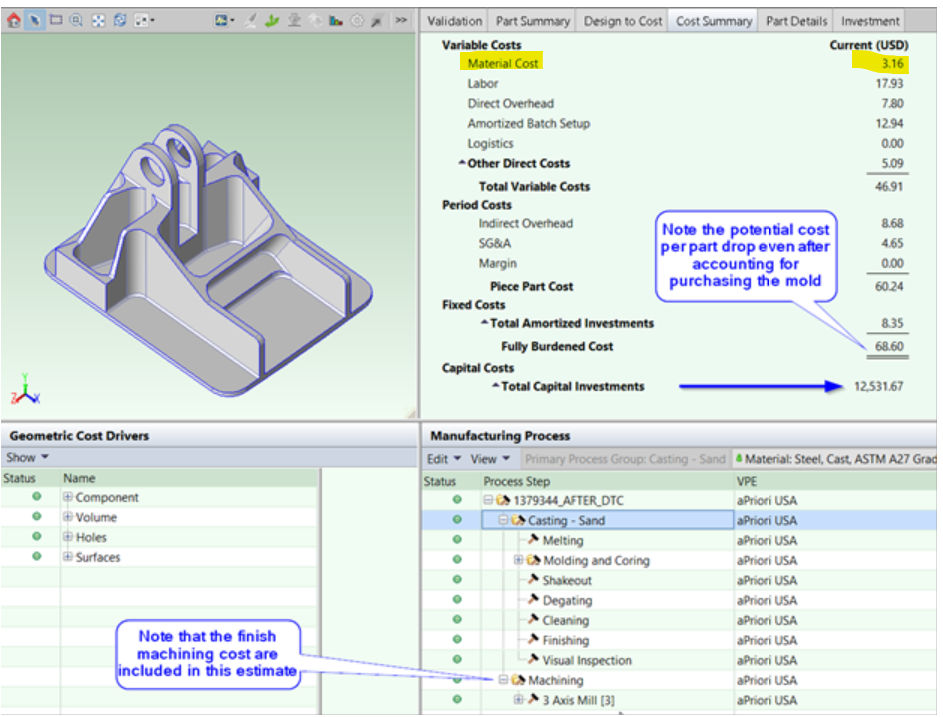7 Ways to Uncover Savings With Automated Cost and Price Analysis
Key Takeaways:
- Digital manufacturing insights software enables engineers to overcome material cost hikes and capture immediate savings
- Leverage aPriori to analyze pricing data and identify cost savings in design and sourcing, including offeror comparisons to select suitable suppliers
The Full Article:
Global supply chain disruptions caused by geopolitical tensions, natural disasters, and other hurdles require organizations to navigate risk and rising material and commodity prices.
Rising material costs can affect your manufacturing, design decisions, and supplier selections. To address inflation and other margin pressures, explore strategies to uncover cost savings by mitigating material costs through digital manufacturing insights software. Explore the following section links to learn more:
- Quick Tips to Reduce Costs Immediately
- How Digital Manufacturing Insights Software Elevates Cost Analysis Accuracy
- 4 Ways Sourcing Teams Use aPriori to Mitigate Costs
- 2 Ways Design Engineers Use aPriori to Lower Material Costs
- 1 Way to Use Alternative Manufacturing Processes to Reduce Costs
- Gain Real-time Cost Insights to Boost Profitability
Quick Tips to Reduce Costs Immediately
During inflationary times, product engineering and sourcing professionals can influence the financial impact of their respective organizations. It is also crucial to understand that suppliers might have their own “price lists” with varying material costs based on volume or future purchases.
There are some immediate cost analysis techniques your organization can take to reduce costs quickly:
- Focus Value Analysis and Value Engineering (VAVE) efforts on minimizing the total amount of material required to manufacture your parts
- Audit future purchases to ensure that suppliers’ proposed price increases are warranted (and have price reasonableness behind them)
- Consider leveraging your large distributor bulk buying contracts already in place. In some cases, it could benefit you to let your supplier purchase from these contracts. It is also important to think about:
- If you can purchase raw materials cheaper than your supplier and are unable to modify current contract prices, consider drop-shipping materials directly to your manufacturing supplier
- Some suppliers may secure material at rates comparable to or lower than yours, even if they have not purchased futures. Don’t overlook these suppliers. Additionally, if they have purchased futures, make sure they pass on the savings to you
- Consider leveraging your large distributor bulk buying contracts already in place. In some cases, it could benefit you to let your supplier purchase from these contracts. It is also important to think about:
Unsure how to boost cost analysis for procurement excellence? Explore our Manufacturing Cost Estimation Guide.
How Digital Manufacturing Insights Software Elevates Cost Analysis Accuracy
Digital manufacturing insights software, such as aPriori, automatically evaluates 3D computer-aided design (CAD) models of physical products to generate cost estimates quickly and accurately for parts/assemblies. Implementing this digital technology benefits in-house product development teams, including:
- Design engineers receive early design process information, identifying manufacturability issues to minimize costly and late-stage engineering change order (ECO) requirements
- Sourcing, procurement, and contracting officers can explore alternative supplier and material options quickly to increase their knowledge across the supply chain. They are also equipped with accurate should cost data to guide supplier negotiations and capitalize on more savings opportunities
- Cost analysis engineers can pinpoint outliers that might impact cost projections and profit margins, thereby enabling the reduction of unnecessary expenses. They can also assess whether the supplier is providing a reasonable price before negotiations even begin
- Manufacturing operations manage product life cycles and timelines more effectively, accelerating time to market (TTM) and boosting product value
- Sustainability managers use aPriori to evaluate design tradeoffs and minimize carbon footprints. This sustainable differentiation enables companies to gain a competitive advantage
Digital manufacturing insights software generates a detailed cost breakdown, allowing users to clearly see the proportion of a part’s cost that lies in the material. For instance, users can calculate the estimated cost for a collection of parts, such as components and similar items purchased from a specific supplier, sheet metal parts included in a product, or all castings contained in a product.
Delve deeper into how aPriori enables manufacturers to determine the actual cost of products.
Below, explore how manufacturing organizations use aPriori to minimize costs across sourcing, design, and manufacturing.
4 Ways Sourcing Teams Use aPriori to Mitigate Costs
Your management team is already aware of the increase in global material costs. You can use digital manufacturing insights technology to demonstrate leadership during a crisis.
The following four examples showcase how sourcing professionals can quickly assess the final price impact from each supplier using digital manufacturing insights software. Screenshots help to visualize the software’s functionality:
Example 1: Quickly identify how much of a part’s cost the material locks in. Advanced manufacturing insights software can clearly show the crucial areas of each part’s cost. With this information, you can quickly identify the parts to focus on first.
Example 2: Ratio of material-to-piece part cost (PPC) for a collection of parts. An engineer or buyer can examine all the steel parts in the assemblies they manage and quickly determine which one has the greatest material cost content to prioritize for mitigation. This includes evaluating the ratio of material-to-piece part cost (PPC) for a collection of components.
Example 3: The impact of material price changes on your product. Companies can use this type of analysis to quickly assess the impact of material cost fluctuations on their products.
Example 4: Is the proposed part cost increase warranted? This example examines the justification behind the proposed cost increases for polypropylene parts in child car seats. Assume you are manufacturing the end product, and the cost of polypropylene has risen by 50%. Most parts have material cost ratios between 38% and 52%. If the supplier proposes a 21% price increase across the board (50% x 42% avg.), you now have the data to negotiate a better deal for part P5724. The data shows that the material cost of this part is significantly lower than that of the others. Therefore, sharing the cost increase with the supplier should only result in a 5% price hike.
2 Ways Design Engineers Use aPriori to Lower Material Costs
Digital manufacturing insights software generates manufacturing information along with critical design-stage feedback. aPriori’s cloud-based software determines the entire manufacturing routing from a CAD model, eliminating the need for an engineer to specify the production process for the part. Design engineers employ aPriori’s in-app guidance within their CAD application to boost productivity and improve innovation in their workflows.
The following example identifies how design changes to this school chair can affect cost (as well as manufacturability):
Example 5: School chair with high material cost content. In this example, an engineer used digital manufacturing insights software to cost this chair. The software revealed that material contributors account for 67% of the part’s cost. Because the material is already the least expensive option available, the engineer needs to decrease the quantity of material in the chair without compromising the seat’s integrity.
Using digital manufacturing insights software enables the engineer to see the real-time impact of the material cost with each design change. To start, the engineer reduces the thickness of the plastic by tapering it from the top edge of the back to about two-thirds of the way down and from the edge of the seat to about halfway across the seat portion. This change reduced the average thickness from 0.18” to 0.15”.
As a result, material cost, labor, and overhead costs all decreased, resulting in savings of $0.95 on a $5 part.
Example 6: This second design change option for the chair barely moved the needle, and the engineer determined it was not worth making. The engineer then considered making the hole in the back of the chair slightly larger from its original 5” width to 6”. This change resulted in a material cost reduction of only $0.07. The engineer determined that risking potential quality issues or increased customer discomfort was not worth this reduction.
The value of receiving real-time cost feedback from digital manufacturing insights software at the speed of design enables engineers to identify these false starts earlier in the product development process.
1 Way to Use Alternative Manufacturing Processes to Reduce Costs
Digital manufacturing insights software not only provides real-time feedback for sourcing parts and refining designs, but it also allows the imitation of other manufacturing methods to compare costs.
This example displays the power of on-demand manufacturing information.
Example 7: Are we using the right manufacturing process? In this example, a quick review identified the part’s cost as having a 40/60 split between material cost and manufacturing cost. This implies opportunities for cost reduction may exist on both sides of the split.
Because the part has a relatively low volume (300 units per year), the company purchases it as a machined part. Figure 9 illustrates how manufacturing insights software guides the engineer in pinpointing ways to reduce expenses.
Additional views in the manufacturing insights software reveal more details about where the costs are allocated, providing actionable clues. By assessing costs with manufacturing insights technology, the engineer discovered that the material utilization was only 11% (indicating that nearly 9 lbs. out of every 10 lbs. of raw material ended up as waste!).
Further investigation determined that machining, especially during roughing operations, accounted for most of the part’s production cost, not the finishing phase. These findings demonstrated that bringing the part near the net shape fueled significant material and manufacturing expenses.
Is there an alternative for manufacturing this part? The engineer designated this part as a machined component due to its relatively low production volume of 300 units per year. However, upon reviewing the cost evidence, the engineer decided to investigate sand casting the part. This resulted in a substantial material cost reduction, from the original $88 to just $3, and it also lowered the manufacturing costs.
Gain Real-time Cost Insights to Boost Profitability
A manufacturing insights platform empowers your engineering and sourcing teams to combat today’s intense material cost increases and make products less sensitive to future cost increases in the material.
A Guide to Manufacturing Cost Estimation
How much will your product cost to produce? And where can you save? Explore all the separate cost elements aPriori evaluates in our Guide to Manufacturing Cost Estimation!



















